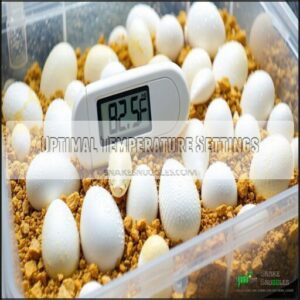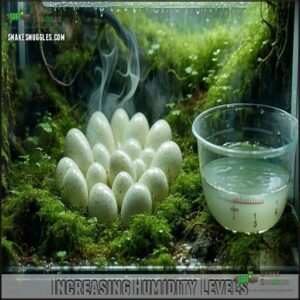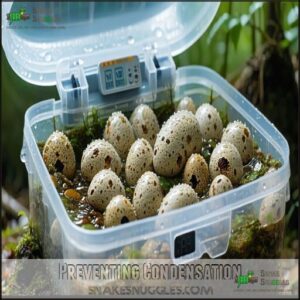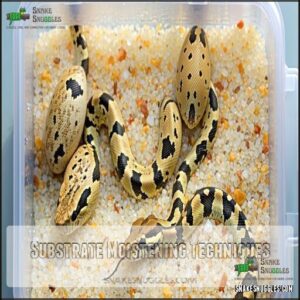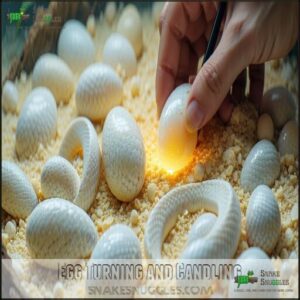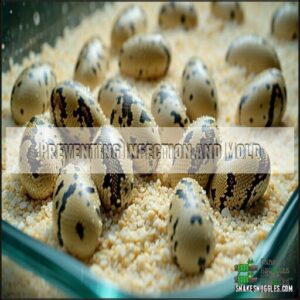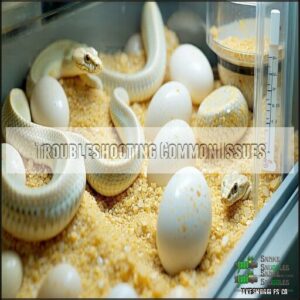This site is supported by our readers. We may earn a commission, at no cost to you, if you purchase through links.
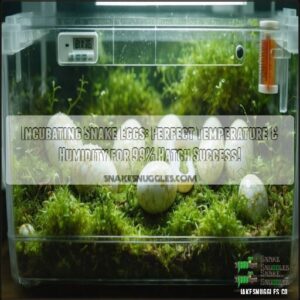
Most snake eggs thrive at temperatures between 80-90°F (27-32°C), with humidity levels of 90-100%.
Think of yourself as creating a mini tropical climate – warm and moist, just like their natural nesting sites.
Different species have slightly different requirements: ball pythons prefer 88-90°F, while corn snakes do better at 82-85°F.
You’ll want to check your incubator twice daily to confirm conditions remain stable and ensure a successful hatch, as the difference between a successful hatch and a failed one often comes down to those vital few degrees and percentage points of moisture.
Table Of Contents
Key Takeaways
- You’ll need to maintain specific temperature ranges (80-90°F) and high humidity levels (90-100%) for most snake eggs, creating a mini tropical climate similar to their natural nesting sites.
- Different species have unique requirements—ball pythons prefer 88-90°F with 90-100% humidity, corn snakes thrive at 82-85°F with 70-80% humidity, and king snakes do best at 75-82°F with 65-75% humidity.
- You should check your incubator twice daily to confirm stable conditions, as even small fluctuations in temperature or humidity can significantly impact hatching success rates.
- Unlike bird eggs, you don’t need to turn snake eggs daily, but should use proper substrate (vermiculite, perlite, or sphagnum moss) and prevent condensation through adequate ventilation to avoid mold growth.
Snake Egg Incubation Basics
You’ll need to maintain specific temperature ranges (80-85°F for most species) and humidity levels (65-85%) to successfully incubate your snake eggs.
Your careful attention to these two factors, along with proper egg handling and equipment setup, will dramatically increase your hatching success rate to nearly 99%.
Temperature Requirements
Maintaining precise temperature requirements is essential for successful snake egg incubation.
The ideal range varies by species: Ball Pythons need 86-92°F (90°F recommended), Corn Snakes require 78-84°F (82°F ideal), and King Snakes thrive at 75-82°F (80°F ideal).
Regular thermometer calibration helps prevent temperature fluctuations that could reduce hatching success.
Even a few degrees outside the optimal incubation temperature can substantially impact embryo development.
Consistent monitoring of basking surface temperature is also critical for healthy snake development.
Humidity Levels
In the realm of successful snake breeding, humidity levels can make or break your hatch rate.
Most snake eggs require 65-85% humidity, with species like ball pythons needing 90-100%.
You’ll need proper humidity monitoring to prevent eggs from drying out or developing deadly condensation.
Your substrate choice directly impacts hydration importance. Remember, ideal incubation humidity varies by species – what works for corn snakes won’t necessarily work for king snakes.
Incubation Equipment
Now that you understand proper humidity levels, you’ll need the right tools for success.
A quality reptile incubator with reliable temperature control forms the backbone of your setup. Pair it with accurate thermometers and hygrometers to monitor conditions constantly.
Your substrate options include vermiculite, perlite, or sphagnum moss. Many breeders achieve excellent results with DIY incubators using plastic containers, heat tape, and thermostats—often at a fraction of commercial costs.
You can find a reptile incubation product online.
Egg Handling Techniques
Proper egg handling techniques can increase your hatch success rate by up to 95%. Always handle snake eggs with clean hands or nitrile gloves to prevent contamination.
Handle snake eggs with care; clean hands or gloves are essential to prevent contamination and ensure up to 95% hatching success.
- Sanitizing eggs with gentle antimicrobial solutions removes harmful bacteria
- Gentle rotation preserves the embryo’s orientation during egg collection
- Marking the top helps guarantee proper placement in the incubator
- Avoiding damage requires minimal touching of the fragile shell
- Identifying viability through candling helps remove infertile eggs
Proper handling is crucial for the hatch success rate, and following these guidelines can significantly improve the chances of a successful hatch.
Optimal Temperature Settings
You’ll need to maintain a precise temperature range of 80-85°F for most snake eggs, with specific requirements varying by species.
Your incubator’s temperature setting directly affects development speed and hatch success, so invest in a reliable thermometer and check it daily.
Ball Python Temperature
For successful ball python eggs, you’ll need precise temperature control.
The ideal range falls between 86-92°F, with 90°F being the sweet spot for ideal hatching success.
| Temperature (°F) | Effect on Incubation | Incubation Duration |
|---|---|---|
| Below 86°F | Slow development | Extended (65+ days) |
| 87-88°F | Good development | 60-65 days |
| 89-90°F | Perfect development | 55-60 days |
| 91-92°F | Faster development | 50-55 days |
| Above 92°F | Genetic abnormalities | May not hatch |
Corn Snake Temperature
While ball pythons need warmth, corn snakes prefer slightly cooler conditions for successful egg development. For ideal corn snake egg incubation temperature, maintain a steady 78-84°F, with 82°F being the sweet spot.
Your eggs should hatch within 58-62 days when kept at this ideal range.
Here’s what you’ll need for perfect corn snake egg incubation:
- Reliable thermometer (calibrated weekly)
- Temperature controller with 1°F precision
- Secondary thermometer for verification
- Record-keeping system to track temperature fluctuations
- Insulated container to minimize external temperature impacts.
Temperature consistency matters more than perfect readings—minor fluctuations won’t substantially affect hatching success if you stay within the recommended range. Temperature consistency is key, and it’s essential to maintain a stable environment for successful incubation, ensuring the eggs hatch within the expected 58-62 days when kept at the ideal temperature, which is crucial for successful egg development.
King Snake Temperature
When incubating king snake eggs, maintaining the ideal range of 75-82°F is vital for maximum hatching success.
Your incubator should be set at approximately 80°F, which supports a 55-75 day incubation duration.
Temperature fluctuations outside this range can substantially impact development.
Genetics also influence how your king snake eggs respond to specific temperature conditions, so monitoring with a reliable thermometer helps guarantee your 99% hatch rate goal, and achieving this requires careful control of the incubation environment to ensure maximum hatching success.
Temperature-Dependent Sex Determination
Unlike king snakes, many reptiles display Temperature-Dependent Sex Determination (TSD), where incubation temperature determines hatchling sex rather than genetics.
Temperature shapes destiny in reptile eggs—what could be male becomes female with just a few degrees difference.
While common in turtles and lizards, most snake species don’t exhibit TSD.
For reptiles with TSD, here’s what happens:
- Lower temperatures often produce males in turtle eggs
- Higher temperatures typically yield females in many species
- The middle third of incubation is most critical for sex determination
- Specific "pivot points" exist where 50% males/females develop
- Global warming could skew wild population sex ratios
This phenomenon has significant implications for the survival and balance of these species, particularly in the context of environmental changes.
Humidity Control Methods
You’ll need to control humidity levels between 65-90% for your snake eggs using proper substrate moistening and ventilation adjustments.
Regularly monitor humidity with a reliable hygrometer and make small, consistent changes rather than dramatic fluctuations that could stress developing embryos.
This ensures the embryos develop in a stable environment, which is crucial for their development.
Maintaining Optimal Humidity
Now that you’ve set the right temperature, maintaining ideal humidity levels is your next challenge.
Consistent humidity prevents dehydration while avoiding excess moisture that can lead to mold.
Your humidity monitoring routine should be as regular as your temperature checks.
| Species | Ideal Humidity | Substrate Choice | Checking Frequency |
|---|---|---|---|
| Ball Python | 90-100% | Vermiculite/Water (1:1) | Twice daily |
| Corn Snake | 70-80% | Perlite/Water (1:0.8) | Daily |
| King Snake | 65-75% | Hatchrite | Every 2 days |
| Milk Snake | 75-85% | Sphagnum Moss | Daily |
The table provides a quick reference for the specific needs of different species, including Ball Python, Corn Snake, King Snake, and Milk Snake.
Increasing Humidity Levels
Now that you’ve established a baseline humidity level, you might need to increase it when readings drop.
To boost humidity levels for snake eggs, try misting the substrate (not directly on eggs) with tepid water every 1-2 days. Add water bowls inside your incubator or introduce damp sphagnum moss.
A key component is the incubator’s water source for maintaining proper humidity.
Using a reliable hygrometer is essential – calibrate it regularly to prevent humidity fluctuations that could harm your developing eggs.
Preventing Condensation
While you’ve raised humidity levels, too much moisture can be just as harmful.
Condensation forms when water droplets collect on surfaces inside your incubator, potentially drowning snake eggs or promoting dangerous mold growth.
Here’s how to prevent condensation during snake egg incubation:
- Verify proper airflow importance by adding small ventilation holes in your container
- Select substrate choices that balance moisture retention without becoming waterlogged
- Implement ventilation strategies with a small fan on low setting
- Monitor egg placement away from container walls where condensation forms first
- Watch for condensation indicators like fogging on container sides or water droplets
By following these steps, you can help ensure a safe and healthy environment for your snake eggs to incubate, and prevent issues related to moisture retention and condensation.
Substrate Moistening Techniques
While condensation drips can harm snake eggs, proper substrate moistening creates the perfect environment for successful hatching.
Mix equal parts vermiculite or perlite with water until it clumps when squeezed but doesn’t drip. For ideal moisture retention, bury eggs halfway in the substrate.
Check moisture levels regularly and add water gradually as needed. Maintaining proper humidity is vital to avoid dehydration and shedding problems.
Products like Hatchrite or Pangea Hatch offer excellent hydration methods without soaking eggs, preventing mold while maintaining humidity, and can be found through links such as Maintaining proper humidity.
Incubation Best Practices
You’ll need to monitor your snake eggs daily for proper development, checking temperature and humidity levels while gently examining for signs of mold or decay.
Regular egg turning prevents embryo sticking and improves hatching success rates, while carefully observing development through candling helps you identify and address potential problems early, ensuring proper development.
Egg Turning and Candling
Now that you’ve got humidity under control, let’s talk about egg turning and candling – two techniques that can boost your hatch rate substantially.
Unlike bird eggs, snake eggs don’t require daily turning.
Here’s what you need to know:
- Check egg positioning weekly rather than daily to minimize stress on developing embryos
- Use candling (shining light through eggs) to assess embryo development and viability
- Mark the top of eggs with a pencil to track any inadvertent movement during incubation to ensure a successful hatch with proper incubation.
Monitoring Temperature and Humidity
Regular monitoring of your incubation setup is essential for snake egg success. Check temperature and humidity readings twice daily using calibrated sensors.
Digital data logging systems can track fluctuations over time, while remote monitoring allows you to keep tabs even when away. A vital tool is a digital hygrometer incubator.
Install alarm systems that alert you when conditions fall outside acceptable ranges. Always have backup systems ready in case primary temperature or humidity controls fail, to ensure continuous monitoring.
Preventing Infection and Mold
Three critical steps help prevent infection and mold in your snake egg incubation setup.
First, use sterile substrates like vermiculite that naturally resist fungal growth.
Second, practice proper egg cleaning with gentle handling while wearing gloves.
Third, make certain adequate air circulation without excessive humidity.
For successful hatching, remember that eggs need specific temperature conditions.
Consider safe antifungal agents for the incubation container and implement quarantine protocols for new eggs to prevent bacterial contamination and mold growth.
Troubleshooting Common Issues
While keeping your eggs free from mold is essential, you’ll likely face other challenges during snake egg incubation.
When egg collapse occurs, it’s typically a sign of dehydration—immediately increase humidity levels.
Mold growth requires removing affected eggs to prevent spread.
Temperature spikes or humidity fluctuations can cause hatching problems, so check your equipment daily.
Consistent temperature control is essential for healthy hatchlings.
If eggs develop unusual discoloration or odors, consult a reptile veterinarian for specialized advice.
Post-Hatching Care Guidelines
You’ll need to provide proper care for your newly hatched snakes within 48 hours of emergence, including appropriate feeding and housing with temperature gradients specific to their species.
Monitoring your hatchlings for signs of distress and maintaining suitable environmental conditions will substantially increase their chances of survival during this critical period of development, which involves careful observation and maintenance of their health to ensure they thrive, with a focus on temperature gradients.
Newborn Snake Feeding
Most newborn snakes require their first meal within 48-72 hours after hatching. Offer appropriately-sized prey (pinky mice for most species) that’s 1-1.5 times the width of the snake’s midsection.
Begin with pre-killed or frozen-thawed food for safety. Feed hatchlings every 5-7 days initially. If your newborn refuses food, minimize handling, and try feeding at night when they’re naturally more active.
A vital aspect is maintaining they’ve proper humidity levels for healthy shedding. This is crucial for the snake’s overall well-being, especially during the initial stages of growth and development, and ensuring they receive the right conditions for a proper start.
Suitable Housing and Temperature
After hatching, create a safe hatchling enclosure with proper temperature gradient for your tiny serpents.
Their species needs determine specific heating methods:
- Heat mats provide gentle warmth from below, allowing natural thermoregulation
- Overhead lamps mimic natural sunlight for day/night cycles
- Thermostats control temperatures precisely, preventing dangerous fluctuations
- Small water dishes help maintain humidity without drowning risk
Most hatchlings thrive at 78-85°F with a cooler side around 75°F.
Always use thermostats with any heating equipment.
Monitoring for Distress
Now that your baby snakes have proper housing, watch for signs of distress.
Check for normal hatchling behavior—active movement and regular tongue flicking indicate health. Look for breathing problems, incomplete yolk sac absorption, dehydration signs (wrinkled skin), or physical abnormalities.
During reptile egg incubation, some issues aren’t visible until after hatching. Monitor each snake individually, as ideal snake egg temperature and humidity during incubation don’t guarantee perfect hatchlings, and be aware of the potential for hidden issues until they become apparent, affecting the snake’s overall well-being.
Consulting Experts for Advice
When faced with unexpected challenges after hatching, consulting qualified experts becomes your lifeline.
Reach out to professionals who can provide personalized guidance:
- Find breeders with proven track records in snake egg incubation temperature management
- Verify expert qualifications and species specificity in their advice
- Consider ethical considerations when seeking breeding programs assistance
- Document all long-term care recommendations
- Join reptile forums where experienced keepers discuss incubation best practices
Don’t hesitate to ask questions – even experienced snake breeders were beginners once, and seeking help is a key part of long-term care and breeding programs.
Frequently Asked Questions (FAQs)
How long can eggs survive transport?
An amazing 100% survival rate was documented with 32 clutches transported for 3 hours.
You can safely move your eggs up to several hours if you’ll maintain proper orientation and temperature using a secure container with substrate.
Does incubator location affect hatching success?
Yes, your incubator’s location can impact success rates.
You’ll want to place it somewhere with stable temperature, away from drafts, direct sunlight, and vibrations.
Consistent conditions help promote healthy development of your eggs, which is crucial for stable temperature control and overall incubation success.
Can clutchmates hatch at different times?
Birds of a feather don’t always hatch together.
Yes, clutchmates can emerge at different times, with variations of 1-3 days being common even under identical conditions.
This staggered hatching is perfectly normal.
Do egg markers affect embryo development?
Marking eggs with pencil or non-toxic markers won’t harm embryos if done lightly.
You’ll want to avoid using toxic chemicals or pressing too hard, which could damage the porous shell during development.
How do power outages impact incubating eggs?
During those tense moments when power fails, your incubating eggs face temperature drops that can slow development.
Brief outages (under 12 hours) usually aren’t fatal, but longer ones may require emergency heat sources.
Conclusion
Perfectly practicing proper temperature and humidity control is your pathway to successful snake breeding.
Remember, incubating snake eggs requires consistent temperatures between 80-90°F and humidity levels of 90-100%, with species-specific adjustments.
Your diligence in monitoring these conditions twice daily will dramatically improve hatch rates. With the right equipment and careful attention to these critical environmental factors, you’ll transform from novice to expert in incubating snake eggs.
Temperature and humidity truly make all the difference, and by focusing on these aspects, you can achieve success in snake breeding, making it a successful endeavor.
- https://www.petplace.com/article/reptiles/general/snake-egg-incubation
- https://www.pethospitalpq.com/sites/site-3953/documents/Incubation%20of%20Reptile%20Eggs.pdf
- https://community.morphmarket.com/t/incubation-temps/30049
- https://bobclark.com/blogs/articles/python-egg-incubation?srsltid=AfmBOor5L67FjQEucPCdeg0DDV0tCqZzD4CFONyYsUn6pKJAiJxn0Bnw
- https://incubatorwarehouse.com/pages/reptile-incubation-time-and-temperature?srsltid=AfmBOoovkvDLwnvU5EPilk_Ns_lLrJ4J32hrfNcDkni765PDsDLmogZ7


